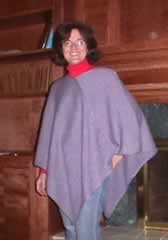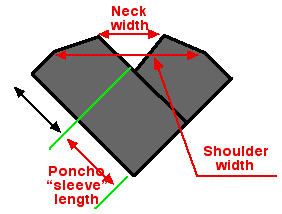 Poncho IV: "Two Rectangle"
Poncho IV: "Two Rectangle"
This
page has a pattern generator (aka program) to create a poncho pattern
for you. You can make your poncho shorter or longer, use yarn
like mine, or use heavier yarn. The generator will spit out
the pattern you want.Main site, blog, Poncho collection, off-site poncho links
You must set your browser to run javascript and to accept cookies to run this program.
Type: Knit as two rectangles (with optional shoulder darts).
Characteristics of the poncho on this page:
- is knit as two rectangles with shaping at the shoulders.
- is worn with a point down the front.
- can be hand knit or machine knit in any gauge. However, the directions are worded for machine knitters, as I give row counts instead of lengths from cast on. Hand knitters will want to read the notes which provide information to convert the pattern to HK terminology.
- has optional darts near the shoulders to prevent
the "neck cone" or "bump" you see in traditional ponchos.
- if
you knit the optional darts, you must choose stitch that permits you to
work short rows. (Short rows are nearly always possible
when hand knitting. On my Passap, they are very difficult to work if
I choose tuck stitch.)
- you need to know how to operate your knitting machine or how to hand knit.
- an optional little "V" to fill in the back neck so the poncho doesn't slide forward.
- The generator estimates how much yarn you need if you knit the poncho in stockinette.
Remember: Like all patterns spit out by my generators, this is
mostly shapingdirections.
The purpose of the generators is to let you be
creative, while eliminating the need to do pesky
calculations. Depending on the generator, you may get a lot of
design information which you may ignore or figure out depending
on your personality. You can always just imitate the poncho
picture!
In any case, with this poncho, you decide how long you want your poncho, how
wide you want the neck and how wide your shoulder are. That's it. You pick your yarn,
needles etc. I sometimes make
some suggestions; but they won't be detailed.
Lucia
 You will need to design your poncho. You must pick a
You will need to design your poncho. You must pick a